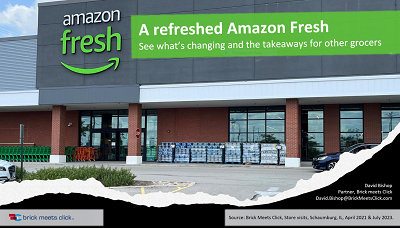Managing price inflation in Grocery: Why this round is doing to be different - new rules/new tools
Complete the form below to instantly download this month's dashboard.

While product availability has been a top-of-mind problem most recently,inflation is lurking in the background and how a retailer chooses to respond requires some serious consideration.
Grocers have usually liked some inflation, however this next round may be different for two reasons. First, some consumers are shifting their spending instead of accepting higher prices. Big retailers like Walmart, Target, and Aldi are already growing market share, while many other retailers are losing it. Second, retailers now have new tools for dealing with product cost increases.
Here are the key points that all grocery retailers need to keep in mind to put this looming challenge into context, based on research we did recently for a short client presentation.
Lessons learned about managing food price inflation
For the last 20 years, food inflation has hovered around 2%, but now it’s running over 4% with the producer price index increasing to 8% in August 2021.
The last long run of inflation happened in the 1970s. During that time, there was lots of change.
- After enduring price controls, manufacturers aggressively raised their prices to avoid getting caught again and dealt back a lot of those price increases to stay competitive.
- Wholesalers and retailers increased their forward buying to lock in low prices.
- Consumers traded down purchases leading to an increase in private label sales (including even lower price generics for a time).
What type of inflation is ahead for 2022 and beyond?
No one expects the coming round of inflation to reach high the highs of the 70s, but a September 23 article in The Wall Street Journal (“ General Mills says costs keep rising ”) reports that the company expects input cost inflation of 7-8% for fiscal 2022 – and that should get every grocer’s attention.
New factors = new RULES
Most food retailers would prefer to pass on price increases to maintain their margins but that approach will be more difficult in the current competitive landscape for several reasons.
- Market power: Grocery retailing has grown more concentrated, and the larger players have greater ability to slow price increases from suppliers.
- Hard Discounters: The growing discount segment is motivated to hold down prices and operates retail business models designed to control costs.
- Private Label: The increase in higher-quality private label products offers consumers savings with little sacrifice in quality.
Today, grocery retailers are already responding to the uptick in inflation in different ways. The largest mass marketers like Walmart and Target are taking small price increases and seeing their shares grow. In contrast, High/Low grocery operators are passing on more of the price increases to consumers and seeing some share loss.
New factors = new TOOLS
The good news is that this share loss can be minimized or even reversed, since grocers now have more ways to manage price increases – if they evaluate their options and make informed decisions.
- Identifying Pricing Opportunities: The increased availability of accurate and timely price comparison data can make it easier to take advantage of pricing opportunities by managing price gaps right down to the local market.
- Raising Online Prices: Online grocery shoppers have demonstrated a willingness to pay more for this service, yet many grocers haven’t taken advantage of this and are still charging the same prices in-store and online.
- Managing Price Image: Modern data analytics can identify known value items (KVIs) at the local level to guide improvements in overall price image.
Taking full advantage of these newer price management tools is especially important to grocers when other channels such as pure play ecommerce, drug, and mass are using them to offset inflation and gain market share.
Now is the time to consider these approaches and tools because those whochoose to embrace them will fare better than those who don’t.
Related Posts
> Inside Track: How to Navigate the Upcoming Challenges in Pricing and Promotion
> Aldi's new hybrid pricing strategy: Hidden in plain sight
> Build a more profitable sales mix without raising prices using the Halo Effect
Brick Meets Click is a US grocery analytics & strategic insightfirm that helps organizations make sense out of the changing market. We deliver objective, fact-driven guidance on how business is evolving andwhere there are emerging opportunities and/or threats so companies can proactivelyrespond. Learn more about our services .












